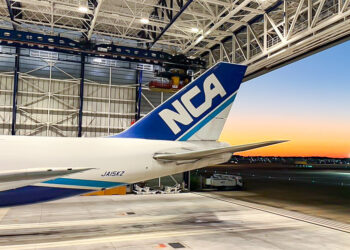No products in the cart.
The widebody freighter fleet — Part III
In Parts I and II of this analysis of the widebody jet freighter fleet as it stood at the end of January 2018, we have offered an overview of the entire fleet – which carriers are operating which freighters – and examined the ways in which the fleet has changed – both in the last twelve months, and over the last six years – on a type-by-type basis. You can read Part I here, and read Part II here. Next week we will continue this analysis with a detailed breakdown of the fleet from a variety of perspectives.
Today we turn from aircraft to operators, and then look at the current production freighter backlog and also the conversion landscape.
The chart in Part I showed that, at the end of January, a total of seventy-three carriers operated 1,035 widebody freighters. This is down from seventy-five last year (and seventy-nine the year before, and eighty-five the year before that) as four carriers have ceased widebody freighter operation (or gone out of business altogether), while two new carriers have entered the list, and one carrier changed its name.
Gone from last year are:
- Afriqiyah Airlines: This Libya-based carrier put its single A300-600F in storage
- AHS Air International: Pakistan-based AHS, which had one 747-200F, went out of business.
- Bravo Air: The Georgia-based carrier went out of business. Its single 36-year-old A300B4 has been transferred to Geo Fly Airways – a Georgian startup that hasn’t yet started up.
- National Airlines: US-based National is still in business, but appears to be flying its two 747-400BCFs exclusively for the US military.
New to the list this year are:
- 21 Air: US-based 21 Air is now operating the two 767-200Fs that Dynamic Airways operated for it two years ago.
- AMS Airlines: This Georgia-based airline is now operating an A300B4F for DHL International Aviation Middle East.
Also appearing for the first time is Suparna Airlines. However, this Chinese carrier is new in name only, having been rebranded from Yangtze River Express.
In addition to the active freighters shown in the charts, there are a large number in storage. This includes many older types that will never fly again, but also includes some fifty 747-400Fs (both production and converted), fifty MD-11Fs, and a few A300-600Fs. Many of these could be returned to service if required, but Cargo Facts believes that most of them will stay on the ground. Falling oil prices in past years brought some out of retirement, but given the proliferation of belly capacity, the backlog of new freighters that will be delivered over the next few years, the increasing age of the parked units, and higher oil prices, we do not expect many of them to come out of the desert – even in the current high-demand environment.
 Regarding the backlog, as shown in the chart at right, ten carriers, one lessor, and one unidentified customer have 122 widebody production freighters on order with Airbus and Boeing. Of these orders, 61% – eleven 777Fs and sixty-three 767-300Fs – are for FedEx. The remainder are spread among the other nine carriers, lessor Hong Kong International Aviation, and one unidentified customer.
Regarding the backlog, as shown in the chart at right, ten carriers, one lessor, and one unidentified customer have 122 widebody production freighters on order with Airbus and Boeing. Of these orders, 61% – eleven 777Fs and sixty-three 767-300Fs – are for FedEx. The remainder are spread among the other nine carriers, lessor Hong Kong International Aviation, and one unidentified customer.
In addition to the outstanding orders for production freighters, there has been an upsurge in orders for P-to-F conversions in the last three years. Air Transport Services Group, Atlas Air, Kalitta Air, and UPS all have orders in place with Bedek Aviation Group and/or Boeing for 767-300 conversions, while EFW has taken orders for A330-200 and -300 P-to-F conversions from Egyptair and DHL, respectively.
The exact number is unclear at this point, but the combined backlog of 767 and A330 P-to-F conversions is certainly greater than thirty, so the total freighter backlog – production and conversion – is likely between 150 and 160. This is down from last year’s 150 production freighters and thirty-five conversions, and even further down from 2016’s 164 production freighters and thirty-five conversions.
There are currently active programs for P-to-F conversion of 747-400s (Bedek), A330-200s/-300s (EFW), 767-300s (Bedek and Boeing), and A300-600s (EFW and Turkish Technic). Of these, the 747 program is effectively dead, and once EFW completes the two A300-600 conversions currently in its backlog, that program, too, is unlikely to see any more orders.
But continuing demand for 767-300 conversions means that Bedek and Boeing will have their hands full for at least a couple more years. And, as demand for 767 conversions begins to wane (due to a shortage of suitable feedstock), A330-300 conversions should take up most of the slack. Regarding the A330, Airbus launched conversion programs six years ago for both the -200 and -300 variants, through a joint venture with EFW and ST Aerospace. So far, Egyptair is the only customer for the A330‑200P2F, with a two-conversion order, but DHL has now firm-ordered eight A330‑300P2F conversions, with options for ten more.
Cargo Facts expects that demand for freighter converted A330s, particularly the -300, will eventually be strong. And while demand for 767‑300 conversions cannot last forever, it will remain strong for at least the near future.
Want to learn more about the future of the air freight industry, particularly in regard to the growth and distribution of freighter aircraft? Then join us at this year’s Cargo Facts Asia, to be held 23-25 April at the Mandarin Oriental Pudong in Shanghai. 




